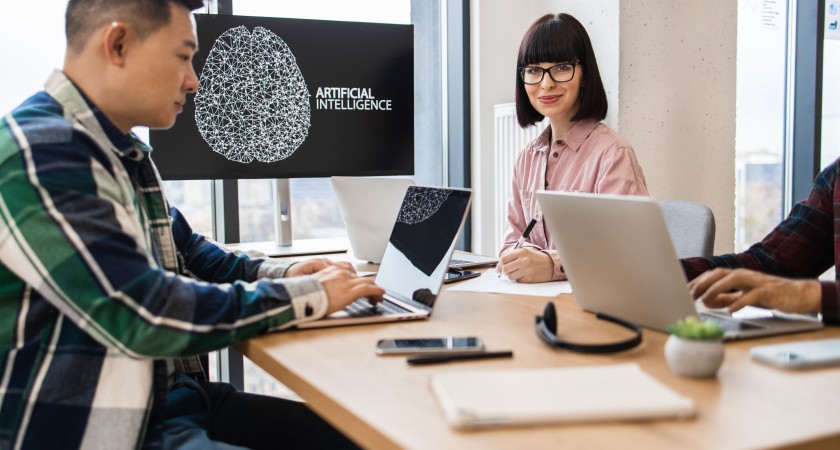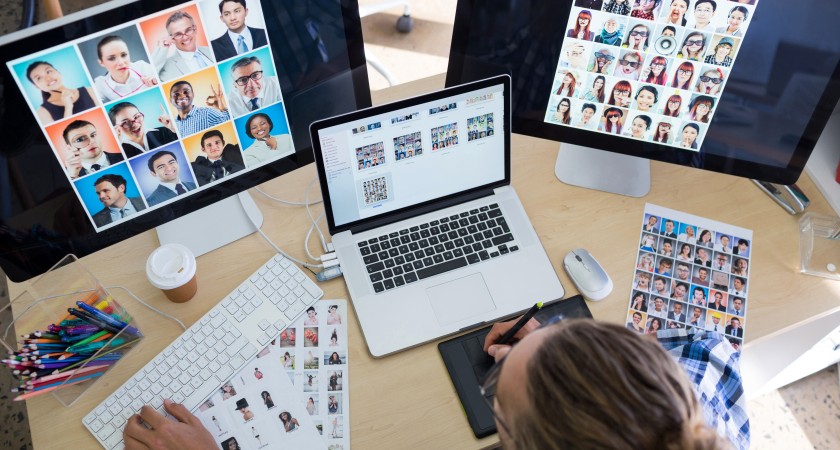 AI Recruitment
AI Recruitment

Divij Chadha
Quick Read
Summary is AI-generated, benefits of ai in recruitment -reviewed

In this blog the article outlines the benefits of AI in recruitment, focusing on efficiency and predictive insights. AI assists in sourcing, resume screening, candidate matching, and automating repetitive tasks, freeing recruiters to focus on strategy and relationships. Predictive analytics improves quality-of-hire forecasts and reduces time-to-fill, while chatbots enhance candidate engagement and experience. The piece acknowledges ethical concerns and bias risk, recommending human oversight, transparency, and careful model training. Implementation tips include integrating AI into existing ATS workflows, monitoring outcomes, and combining algorithmic suggestions with recruiter judgment to deliver fairer and faster hiring.
Hiring people may now be seen as a very time-dependent activity, recruiting, almost a bargaining process. The recruitment function has experienced the need to forecast talent, be reactive at lightning speed, and create a candidate experience consistent with company culture even before the first interview is scheduled. A powerful Artificial Intelligence (AI) is at the core of this metamorphosis.
Consider this: AI in recruitment is far beyond mere automation. It's about building smart workflows that help improve hiring decisions. It's about using predictive analytics in recruitment operations to make talent strategies future-ready and capable of data-driven assessments. But more importantly, the technology seeks to build a recruiter's existing capability and not replace him/her.
This article aims to give readers an introduction to how AI is changing recruitment workflows, what, to name just a few, predictive analytics brings to the table, and the track record of real-world benefits AI recruiting tools can offer when implemented thoughtfully.

The AI Recruitment Workflow: From Reactive to Predictive
Traditional recruitment is a linear process: jobs open, posts go up, applicants invite themselves, resumes get screened by hand (usually), interviews are orchestrated, and finally, one is hired. Traditionally, this is supposed to be an orderly flow, but there's no saying that it has to be effective or quick.
Nowadays, however, the recruitment process has been thoroughly altered and streamlined, with AI inserted at every stage.
1. Role Demand Forecasting
AI-enabled systems work by analyzing internal data such as attrition rates, promotion trends, and workforce expansion plans to predict hiring needs on a timely basis. Rather than react to an opening, recruiters are in the enviable position of planning and building talent pipelines in anticipation.
2. Sourcing Automation
The newest AI recruitment platforms no longer rely solely on job boards. They scan millions of online profiles across LinkedIn, GitHub, portfolios, and internal databases to identify potential candidates, many of whom are not actively applying for jobs.
This really extends the reach and diversifies the pool by presenting candidates that might have been overlooked earlier in a manual search procedure.
3. Resume Screening & Candidate Matching
AI doesn't just scan for keywords—it parses resume content for context, intent, and relevance. It ranks candidates based on how closely they align with job requirements, past performance data, and even cultural compatibility if that data is available.
This saves recruiters hours per role and ensures that the shortlist is based on merit, not speed of application.
4. Interview Scheduling & Candidate Engagement
Automated scheduling tools integrated with AI can handle time zone complexities and availability conflicts, and they can even send reminders or rescheduling options, freeing recruiters for actual human interaction.
Meanwhile, chatbots or conversational AI tools can guide candidates through the application process, answer FAQs, and keep them engaged from day one.
5. Candidate Assessment & Evaluation
AI-driven assessment platforms can conduct skill-based tests, analyze language use in written responses, and even evaluate video interviews for speech patterns and sentiment, offering more objective data points to complement human interviews.
While ethical concerns remain around AI-based video analysis, when used responsibly (with transparency and human review), it can help standardize how candidates are evaluated.
6. Hiring Decisions & Predictive Fit
Perhaps the most exciting part of the AI workflow is what happens behind the scenes. Algorithms trained on historical data can flag candidates who are not just qualified, but more likely to succeed based on tenure, performance, and progression trends seen in past hires.
It's not just about who can do the job, but who will thrive in your unique environment.
7. Post-Hire Data Loop
Once a candidate is hired, AI systems can track onboarding success, engagement, and retention. This data feeds back into the recruitment model, improving accuracy for future hires.
Predictive Analytics in Recruitment: Seeing Ahead, Not Just Behind
Recruitment has long been driven by lagging indicators—time-to-fill, cost-per-hire, and source of hire. While these metrics are still useful, predictive analytics in recruitment shifts the focus to what's coming next.
Here's how it works:
Candidate Success Prediction
AI models trained on organizational data can score candidates based on their likelihood of accepting an offer, succeeding in the role, and staying with the company. This minimizes the risk of mis-hires, especially in high-volume or mission-critical roles.
Funnel Optimization
Predictive analytics can show where candidates are most likely to drop out of the process or where bottlenecks are forming, allowing recruiters to optimize stages in real-time.
Channel Forecasting
Using historical data, AI can predict which sourcing channels are most likely to yield top candidates for a specific role: LinkedIn, employee referrals, or industry-specific job boards.
Offer Acceptance Probability
Algorithms can consider candidate behavior, recruiter interactions, offer timing, and even market demand to estimate whether a candidate will likely accept an offer, allowing hiring managers to adjust strategy if needed.
Turnover Risk Modeling
By comparing new candidates with historical employee data, AI tools can flag hires with a higher risk of early departure, giving companies a chance to intervene early.

Real Recruitment AI Benefits: What Happens When Humans and Machines Team Up
The hype around AI recruitment tools is everywhere, but what are the actual, ground-level benefits organizations see when using them correctly?
1. Massive Time Savings
AI eliminates repetitive tasks like resume screening and scheduling. Recruiters can now focus on high-value activities like candidate relationship-building and strategic planning.
2. Improved Quality of Hire
With AI filtering through noise and surfacing high-potential candidates faster, organizations are more likely to land the best fit, not just the fastest applicant.
3. Cost Reduction
Time saved equals money saved. Moreover, predictive hiring reduces the cost of bad hires, which is often far higher than the cost of recruitment.
4. Stronger Candidate Experience
Speedy communication, clear process updates, and personalized engagement—all powered by AI—help create a smoother, more human-feeling experience for candidates.
5. Increased Hiring Equity
By anonymizing resumes and using consistent evaluation criteria, AI helps reduce human bias, though it must be monitored carefully to avoid replicating biased training data.
6. Scalability During Hiring Surges
Whether you're hiring 10 roles or 1,000, AI recruitment workflows scale without requiring an equal increase in recruiter headcount.
7. Better Hiring Decisions Over Time
With every hire, the AI system learns what worked, what didn't, and what should change. Over time, this leads to more accurate predictions, better sourcing strategies, and stronger overall hiring outcomes.
Why Collar Search? Because Tech Alone Isn't Enough
Opportunities abound in AI; however, there are things it cannot do. Tools can automate, but cannot replace empathy, judgment, or cultural fluency. That extra bit gives Collar Search an edge.
We don't just plug in technology-we:
-
Customize recruitment workflows based on industry, location, and role complexity.
-
Audit AI outputs to reduce false-positive results and to identify candidates worthy of consideration on the hidden pathway.
-
Train internal teams to use AI responsibly.
-
Monitor DEI impact to give truly fair and transparent hiring practices.
-
Provide human validation of every decision, from shortlisting to offer rollout.
The intelligent systems are complemented with human intelligence to deliver effortless, equitable, and future-ready hiring results.
Final Thoughts: Smarter Workflows Start with Smarter Strategy
AI in recruitment is not a passing trend—it's the future of hiring. But that future isn't about replacing people. It's about building systems where people and machines work better together.
AI recruitment workflows streamline hiring from end to end.
Predictive analytics in recruitment shifts decision-making from reactive to proactive.
And the broader recruitment AI benefits? Faster hiring, better hires, stronger teams.
But none work without a clear strategy, responsible oversight, and a human-first mindset.
Recruitment isn't just about filling roles—it's about shaping the future of work. And with AI as your ally, that future is smarter, faster, and more connected than ever.
Frequently Asked Questions
-
What are the main benefits of using AI in recruitment?
AI boosts hiring speed, improves candidate matching, reduces manual tasks, enhances candidate experience, and supports more data-driven, equitable decisions.
-
How does AI make the recruitment process faster?
AI automates resume screening, candidate sourcing, interview scheduling, and follow-ups, cutting time-to-hire significantly.
-
Can AI improve the quality of hires?
Yes. AI analyzes skills, experience, and cultural fit to surface top-matching candidates, leading to better job-role alignment and long-term retention.
-
Does AI reduce hiring bias?
AI can reduce bias by anonymizing resumes, standardizing evaluations, and flagging biased language—if it's trained and monitored responsibly.
-
Can AI help with high-volume hiring?
Absolutely. AI handles large applicant pools efficiently, maintaining consistency and speed even during large-scale or seasonal hiring drives.










